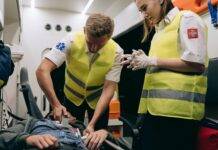
Choking Relief: How to React Swiftly and Safely
Choking Relief : Choking is a potentially life-threatening situation that can occur unexpectedly, posing a serious risk to the person experiencing it. Knowing how to respond promptly and effectively can make all the difference between a minor scare and a major emergency. In this article, we’ll delve into the essential steps of choking relief, ensuring you’re well-prepared to handle such situations with confidence.
Understanding Choking
Choking occurs when an object obstructs the airway, preventing normal breathing. It can happen to people of all ages and can be caused by anything from food particles to small objects. Recognizing the signs of choking is crucial to providing quick assistance.
Identifying Choking in Adults and Children
Both adults and children might display signs of choking, such as clutching their throat, making weak or no sounds, and showing visible distress. In infants, the symptoms can include difficulty breathing and a bluish skin tone.
Immediate Actions to Take
When you encounter someone who is choking, it’s important to act swiftly. Encourage them to cough forcefully, which might help dislodge the obstruction. If this doesn’t work, it’s time to move on to more advanced techniques.
Performing the Heimlich Maneuver
The Heimlich Maneuver is a widely recognized technique for dislodging an object from a choking person’s airway. Stand behind the person, make a fist, and place it just above their navel. Grasp your fist with your other hand and give quick inward and upward thrusts.
Choking Relief for Infants
For infants, the approach is different. Place the baby facedown on your forearm, ensuring their head is lower than their chest. Deliver firm back blows with the heel of your hand between their shoulder blades.
When to Call for Help
If the person choking cannot breathe, cough, or speak, it’s crucial to call for professional help immediately. Keep in mind that even successful dislodgement of the object requires a medical evaluation.
Stay Informed: Choking Prevention
Preventing choking incidents is as important as knowing how to respond to them. Cut food into small pieces, avoid giving small objects to young children, and keep hazardous items out of their reach.
Clearing the Airway: Back Blows and Chest Thrusts
If the Heimlich Maneuver fails, you can perform back blows and chest thrusts alternatively to create enough force to remove the obstruction. Remember to use proper techniques to prevent further harm.
The Role of Gravity in Choking Incidents
Understanding how gravity plays a role in choking incidents can help you position yourself and the person effectively for maximum impact when attempting relief techniques.
Choking in Special Situations: Pregnant Women and Obese Individuals
Certain groups might require modified approaches due to their physical conditions. Tailor your techniques carefully, considering the unique challenges they present.
Remaining Calm Under Pressure
In emergency situations, staying calm is vital. Panic can hinder your ability to provide effective aid. Take a deep breath, focus on the task at hand, and proceed methodically.
Basic First Aid Skills Everyone Should Have
Choking relief is just one aspect of basic first aid knowledge. Equipping yourself with these skills can make you a valuable asset in various emergency situations.
Learning CPR: A Lifesaving Skill
Cardiopulmonary Resuscitation (CPR) is a crucial skill that goes hand in hand with choking relief. It’s an invaluable tool in reviving someone whose breathing or heartbeat has stopped.
Staying Prepared at Home and in Public Places
Emergencies can happen anywhere. Make sure you’re prepared not only at home but also in public places by familiarizing yourself with the locations of first aid kits and emergency exits.
Spread Awareness: Teaching Choking Relief
Empower others by sharing your knowledge of choking relief. Organize first aid workshops in your community or workplace to ensure that more people are equipped to handle emergencies effectively.
Conclusion
Being well-versed in choking relief techniques can truly be a lifesaver. By understanding the signs of choking, learning the appropriate responses, and staying informed about prevention, you can confidently step up to help someone in need. Remember, your quick actions and knowledge can make all the difference in a critical situation.
FAQs (Frequently Asked Questions)
- Can a person make sounds if they are choking? Yes, they might make weak sounds or no sound at all.
- Is it normal for someone to panic when choking? Yes, panic is a natural response, but it’s important to stay as calm as possible to provide effective assistance.
- Can back blows harm the person I’m trying to help? When performed correctly, back blows are unlikely to cause harm and can be very effective in dislodging an obstruction.
- Should I perform the Heimlich Maneuver on myself if I’m alone and choking? Yes, you can perform the Heimlich Maneuver on yourself using a chair’s back or countertop edge.
- Can young children learn CPR and choking relief techniques? While they may not master all the techniques, teaching them basic concepts can help them respond better in emergencies.
























